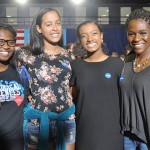By JIM LITKE
AP Sports Columnist
Like just about every other organized youth sports program, the Little League World Series is being played mostly for the benefit of grown-ups. Only it’s way more organized than anything you’re likely to find at the end of your block and the grown-ups who benefit the most aren’t family and friends, but the suits who run Disney and a host of other media outfits.
Little League has been big business for some time, but rarely has business been this good. TV ratings for the nationally televised baseball games on ABC last weekend were up by 40 percent and 20 percent, respectively. That’s in large part because of Mo’ne Davis, a 13-year-old African-American right-handed pitcher from Philadelphia who’s become the “it girl” of the moment. But she’s not the only little leaguer to captivate the sporting public. In Chicago, the hometown Jackie Robinson West team narrowly beat Rhode Island, but as the media-savvy “Sherman Report” noted, they also thrashed the big-league White Sox in Monday night’s head-to-head TV matchup by better than 3-to-1.
Small wonder, then, that Rob Manfred, Major League Baseball’s commissioner-elect, was on hand for Wednesday night’s game between Philadelphia and Las Vegas. In addition to throwing out the first pitch, Manfred had a chance to see for himself what the fuss was all about.
“It’s really a great story for diversity and equality,” Manfred said about an hour before the game, “and I think we should embrace it and hope that she continues to develop.”
The odds that Davis could wind up in the big leagues is practically non-existent, to be sure. And not just because she’s female and African-American _ the number of women who’ve made it to the “show” still stands at zero and the percentage of African-Americans on big-league rosters this past spring, declining for decades, was less than 10 percent.
Mostly, though, it won’t happen because Davis has already mapped out her athletic future, which includes playing basketball at UConn for coach Geno Auriemma, a fellow Philly native, followed by a stint in the WNBA. And it could happen just that way.
“When I was 13, I couldn’t name you a college, that’s how different it is these days with media, social media, with ESPN,” said Diana Taurasi, who’s played both at UConn and in the WNBA. “Everyone knows about everything, even little 13-year-olds. That’s pretty cool.”
No doubt.
But it’s also a pipe dream, even _ maybe especially _ for a youngster as precocious and poised as Davis. What then?
Plenty of people have pondered the question before and arrived at the same answer: Pay the kids.
Granted, the idea hasn’t gained much traction and the details have yet to be ironed out. But you could have said much the same thing about major college football and basketball athletes a few years ago and look where they are vis-a-vis the pay-for-play prohibition now. Texas A&M hardly helped matters by touting a study estimating that Johnny Manziel’s Heisman Award-winning season brought the school $37 million worth of media exposure, and university officials have been backtracking ever since. But a lot of people began more closely following the money in big-time college sports, and it’s only a matter of time before the checks will be in the campus mail.
Even so, paying 13-year-old little leaguers sounds like a stretch. But the most sensible proposals out there trade on some of the same ideas currently floating around the college debate. They suggest paying kids based on TV appearances in the World Series only _ since that’s where the money is; ESPN pays around $4 million annually for the rights and the non-profit Little League Inc. pockets around $3 million _ and putting the money in trust and/or scholarship funds. Yahoo sports columnist Dan Wetzel, who’s advocated doing just that, also did the math and 14 kids per team getting $750 per televised game comes out to $672,000 total _ less than a quarter of the Little League’s annual take.
Davis’ story inspired too many people to count. She pulled in the kind of audience that baseball dreams about _ from young girls to the First Lady, non-sports fans to the cold-blooded major leaguers _ and reminded them what makes the games we watch seem so special every now and then. She also provided hours and hours of free programming for Disney, which has no problem forking over big bucks for all their other proven child stars.
The $4,500 or so Davis would have banked in a college account wouldn’t be much, but it would be a start in case UConn and Auriemma don’t come knocking at her door with a scholarship a few years down the road. And if they do, well, she can use it to make a down payment on one of those nifty vans from the official car company of the Little League World Series _ once she’s old enough to drive it.
___
Jim Litke is a national sports columnist for The Associated Press. Write to him at jlitke@ap.org and follow him at Twitter.com/JimLitke.









